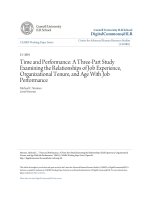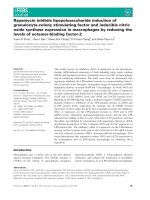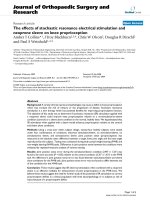the effects of information sharing, organizational capability and relationship characteristics on outsourcing performance in the supply chain- an empirical study
Bạn đang xem bản rút gọn của tài liệu. Xem và tải ngay bản đầy đủ của tài liệu tại đây (751.04 KB, 180 trang )
THE EFFECTS OF INFORMATION SHARING, ORGANIZATIONAL
CAPABILITY AND RELATIONSHIP CHARACTERISTICS ON OUTSOURCING
PERFORMANCE IN THE SUPPLY CHAIN: AN EMPIRICAL STUDY
DISSERTATION
Presented in Partial Fulfillment of the Requirements for
the Degree Doctor of Philosophy in the Graduate
School of The Ohio State University
By
Angela (Tidwell) Lewis, MBA
******
The Ohio State University
2006
Dissertation Committee:
Approved by
Professor Martha C. Cooper, Co-Adviser
Professor John R. Current, Co-Adviser
Professor A. Michael Knemeyer ___________________________________
Co-Adviser
Graduate Program in Business Administration
___________________________________
Co-Adviser
Graduate Program in Business Administrati
on
ii
ABSTRACT
Customer-provider relationships become more important as activities are
outsourced and business becomes more global. Through a study of the
relationships between unpaired third-party logistics (3PLs) providers and
customers, this research addresses how information sharing affects outsourcing
performance in the supply chain. Relationship characteristics and organizational
capabilities are tested as modifiers in the model as an extension of previous
literature, which suggested that those variables influence the strength of the
relationship. The quantitative data are derived from surveys of logistics
executives in the United States. Moderated multiple regression analysis is used
to test the association between information sharing and perceived outsourcing
performance, as well as the interaction effects of organizational capabilities and
relationship characteristics. Results indicate that there is a significant
relationship between information sharing and outsourcing performance. The
moderator relationship variables of communication and perceived satisfaction
with a previous outcome were also significant.
iii
Dedicated to God.
In partial fulfillment of my promise to always give You the Glory.
iv
ACKNOWLEDGMENTS
There are several people that I must acknowledge for their support in getting me
to this final stage.
First, I wish to thank my advisers, Martha Cooper and John Current, for
encouragement, intellectual support and enthusiasm that made this dissertation
possible, and for their patience. This research was supported by the generosity
of John Current and Martha Cooper.
I am grateful to A. Michael Knemeyer for providing guidance, refreshing honesty,
and constructive feedback while discussing various aspects of this dissertation
with me.
I truly appreciate the support of Peter C. Ward, Jeff Pan and Kai Wan, for their
help.
I thank my brother and sisters, Todd, Shawn and Wanda; there is no place for my
thank you to begin or end. You have been there during the difficult times and the
good times along the way. Your presence and prayers have been the greatest
gifts of all. I also thank my niece and nephew, Kiersten and Kameron Tidwell, for
their unconditional love.
And finally, I must acknowledge my greatest cheerleaders my loving parents.
I am forever thankful to my parents, Carnell and Ruth Tidwell, who have loved
and prayed for me through every journey in my life. Dad and Mom, I love you,
you inspire me to go higher.
v
VITA
1994 BS, Florida A&M University
1997 MBA, Washington University
1994 -1995 Industrial Engineer,
General Motors Corporation
1997 - 2002 Material Supervisor, Project Manager,
General Motors Corporation
2002 - 2005 Graduate Teaching and Research Associate,
The Ohio State University
FIELDS OF STUDY
Major Field: Business Administration
Minor Field: Supply Chain Management
PUBLICATIONS AND PROCEEDINGS
Martha C. Cooper, Angela Lewis, and John Santosa. "Career Patterns of
Women in Logistics," CSCMP 2005 Annual Conference.
Martha C. Cooper and Angela Lewis. “Career Patterns of Women in Logistics,”
Mundo Logistico
, Roma, MX, November 2005, pp. 80-86.
Martha C. Cooper, John Santosa, Angela Lewis, and Angelisa Gillyard. "Career
Patterns of Women in Logistics," Council of Logistics Management Conference
Proceedings, 2004.
vi
TABLE OF CONTENTS
Page
Abstract ii
Dedication iii
Acknowledgments iv
Vita v
List of Tables viii
List of Figures x
Chapters:
1. Introduction 1
1.1 Purpose of Research 2
1.2 Problem Statement 3
1.3 Information Sharing 5
1.4 Outsourcing Performance 7
1.5 Relationship Characteristics 7
1.6 Research Questions 8
1.7 Summary of Introduction 8
1.8 Outline of Dissertation 9
2. Literature Review 11
2.1 Outsourcing Defined 12
2.2 Reasons to Outsource 19
2.3 Measuring Outsourcing Performance 33
2.4 Information Sharing 35
2.5 Information Sharing in Supply Chains 36
2.6 Summary of Literature Review 47
3. Research Methods 49
3.1 Hypotheses 49
3.2 Model Formulation 59
3.3 Data Collection 65
vii
3.4 Survey Development 67
3.5 Summary of Research Methods 71
4. Results and discussion 72
4.1 Sample Characteristics 72
4.2 Construct Reliability 78
4.3 Initial Study Analysis 84
4.4 Main Study Results 89
4.5 Additional Findings: Organization Type 96
4.6 Summary of Results 100
5. Discussion and Conclusion 101
5.1 Conclusion Relative to Hypothesis of Information Sharing on
Outsourcing Performance 102
5.2 Conclusion Relative to Hypothesis of Organizational Capability
Moderator 105
5.3 Conclusion Relative to Hypothesis of Relationship Characteristics
Moderator 105
5.4 Conclusions Relative to Other Findings 106
5.5 Contributions of the Research 107
5.6 Managerial Implications 108
5.7 Limitations of the Study 109
5.8 Directions for Future Research 111
5.9 Summary 112
Bibliography 113
Appendices 124
A. Phase 1 Survey 124
B. Phase 2 Survey 142
C. Plots of Residual Values 156
D. Interactions for Gender Differences and Non-Response Bias 161
E. Scatterplots of Customer versus Provider 165
viii
LIST OF TABLES
Table Page
2.1 Outsourcing Definitions 16
2.2 Reasons for Outsourcing 21
2.3 Selected Research Related to Outsourcing from the RBV 24
2.4 Selected Information Sharing Research 41
3.1 Variables for Hypotheses 62
4.1 Respondents by Job Title 73
4.2 Respondents by Industry 74
4.3 Respondents who Provided or Purchased
Logistical Services 76
4.4 Descriptive Statistics of Constructs under Study 77
4.5 Correlation Matrix for the Combined Study 78
4.6 Measure of Information Sharing Construct 79
4.7 Measure of Organizational Capability Construct 80
4.8 Measure of Provider Specific Investment Construct 81
4.9 Measure of Provider Reputation Construct 81
4.10 Measure of Satisfaction with Previous Outcomes Construct 82
ix
4.11 Measure of Communication Construct 82
4.12 Measure of Opportunistic Behavior Construct 83
4.13 Measure of Outsourcing Performance Construct 84
4.14 Regression estimate of information sharing on outsourcing performance 85
4.15 Regression estimate of organizational capability on outsourcing
performance 86
4.16 Regression estimate of relationship characteristics on outsourcing
performance 88
4.17 Regression Results for Information Sharing 90
4.18 Regression Results for Organizational Capability 92
4.19 Regression Results for Provider Specific Investment 92
4.20 Regression Results of Moderating Effect of Provider Reputation 93
4.21 Regression Results of Moderating Effect of Satisfaction with Previous
Outcomes 93
4.22 Regression Results of Moderating Effect of Communication 194
4.23 Regression Results of Moderating Effect of Opportunistic Behavior 95
4.24 Correlation Matrix for Customer Respondents 97
4.25 Correlation Matrix for Provider Respondents 98
5.1 Summary of Hypotheses Tests 104
LIST OF FIGURES
Figure Page
2.1 Lee (2001) Model 46
3.1 Proposed Model 51
3.2 Model of Moderator Effect 52
4.1 Model of Hypothesized Relationships 91
5.1 Model of Hypotheses Tests 103
C.1 Residual Plot for Information Sharing 157
C.2 Residual Plot for Organizational Capability 157
C.3 Residual Plot for Provider Specific Investments 158
C.4 Residual Plot for Provider Reputation 158
C.5 Residual Plot for Communication 159
C.6 Residual Plot for Opportunistic Behavior 159
C.7 Residual Plot for Satisfaction with Previous Outcomes 160
E.1 Customer v. Provider INFOEX Score 166
E.2 Customer v. Provider ORGCAP Score 166
E.3 Customer v. Provider PSI Score 167
xi
E.4 Customer v. Provider PR Score 167
E.5 Customer v. Provider COMM Score 168
E.6 Customer v. Provider OB Score 168
E.7 Customer v. Provider SAT Score 169
1
CHAPTER 1
INTRODUCTION
Increased competitive pressures and stock price concerns are forcing
firms to evaluate which activities should be performed in-house and which can be
outsourced to increase productivity and return on shareholder value. Firms have
opted to outsource activities such as payroll, accounting, customer service, and
logistics. The contracting of logistics functions to an external supplier is referred
to as third-party logistics (3PL). Organizational and relationship measures are
often used to assess the success of a 3PL provider and customer relationship.
Organizational measures may include a firm’s investment in people, technology,
equipment, and processes. Relationship measures may include the ability of
both parties to meet their counterpart’s needs. Consequently, firms are
interested in identifying the factors that influence the success of its 3PL
outcomes. Identifying the critical factors that influence the performance and
relationship measures will assist firms to improve their performance with 3PLs.
2
This chapter will provide an overview of the dissertation. Section 1.1
describes the purpose of the research. The business climate that provides the
background for this study is outlined in Section 1.2. The variables tested in the
study are presented in Sections 1.3 through 1.5. The specific issues addressed
in the research are outlined in Section 1.6. A summary of the chapter is provided
in Section 1.7. Section 1.8 provides an outline of the research.
1.1 Purpose of research
This research examines the relationship between information sharing and
outsourcing performance in a buyer-supplier relationship in the logistics industry.
Information sharing is defined as the exchange of pertinent data that directly or
indirectly influences the outcomes between suppliers and customers (Rhea and
Shrock 2000). Outsourcing is defined as the substitution of external purchases
for internal activities (Lieb and Randall, 1996).
Limited empirical research has appeared on the information sharing-
outsourcing performance relationship, despite its apparent practical importance.
For example, previous research has examined the relationship between
information exchange and logistics supplier performance (Stank et al 1996), as
well as knowledge sharing and outsourcing success in the information
technology industry (Lee 2001). This research attempts to add to this body of
literature by extending the Lee (2001) model to examine relationships between
3
customers and providers in 3PL relationships.
1.2 Problem statement
Approximately sixty percent of Fortune 500 companies report having at
least one contract with a third-party logistics provider (Lieb and Bentz, 2004).
Outsourcing has evolved through deregulation and controversy. Logistics
outsourcing has grown considerably over several years, largely due to transport
deregulation (Spencer, Rogers and Daugherty, 1994). The potential impact on
employees when firms consider the use of outside contractors for logistics
services is often debated. Maloni and Carter (2006) suggest that examining the
effect on worker morale and productivity is a viable research stream for the
future. In many instances, one of the motivating factors for considering such
action is the desire to reduce headcount; nevertheless, the potential negative
impact on company morale cannot be ignored (Lieb and Randall, 1996). This
concern for employees must be balanced against a firm’s ability to compete in
the market.
The global marketplace has placed a tremendous amount of pressure on
companies to improve supply chain performance. Firms must improve
performance to remain cost competitive. Outsourcing has been viewed as a way
for producers to reduce costs. Cost reductions due to outsourcing result from
focusing on core activities and key differentiators; reducing and controlling
4
operating costs; releasing capacity and resources for core projects; gaining
access to world-class capabilities; reducing time-to-market and cycle time;
sharing operational risk; and improving management of functions that are difficult
to manage or functions that are out of control.
Manufacturers and service providers must often make the decision to
outsource when internal capabilities are not cost efficient. One aspect of efforts
to alleviate the pressure for reduced costs has been the outsourcing of support
functions, such as logistics activities. Partnering with a 3PL is a viable approach
to develop, collaborate on, and leverage the capabilities that lead to enhanced
performance (Stank et al. 2003). The advantages and disadvantages of
outsourcing logistics have long been debated but hard, quantifiable evidence on
third-party logistics developments is elusive (Peters et al. 1998). This research
attempts to provide a quantitative measure of the factors that influence 3PL
relationships outcomes. The factors are elaborated upon in the next sections.
5
1.3 Information Sharing
Information sharing has been shown to be one of the keys to successful
supply chains (Whipple et al. 2002). There are various definitions of information
sharing. Lee and Whang (2000) defined it as the transfer of information
regarding inventory levels and position, sales data and forecasts, order status,
production and delivery schedules and capacity, and performance metrics.
Sanders and Premus (2005) view information sharing as “providing firms with
forward visibility, improved production planning, inventory management, and
distribution” in their study of IT capabilities, collaboration, and firm performance.
Information sharing includes, but is not limited to, the transfer of
information in shipment tracing, billing transactions, and complaint resolutions
(
Rhea and Shrock 2000). Suppliers, manufacturers and customers acknowledge
that the exchange of information among them results in a benefit greater than
withholding information. For example, firms may experience excess inventory
when they do not share product demand forecasts. However, when customers
are willing to provide changing forecasts, manufacturers and suppliers can plan
accordingly therefore minimizing the bullwhip effect (Lee and Kim, 1999).
Information sharing has been shown to have a positive relationship with
supplier performance (Stank et al. 1996), and outsourcing success (Lee 2001).
This represents a change of strategy from previous years when suppliers,
6
manufacturers and customers operated in their own silos and watched their
supply chain partners experience the bullwhip effects. As early as 1991, Perry
noted that one of the most important implications for logistics strategy in the
coming decades is the growing importance of information in logistics system
design and operations.
Today information is a resource that is not only becoming
more productive than in the past but also relatively less
expensive when compared to alternative resources (such as
people, material, equipment, and facilities). To a great
extent, innovations in the design and management of today's
forward-looking logistics systems involve the more intensive
use of information to achieve better control and visibility,
resulting in lower logistics costs and better customer service
(Perry 1991).
Research over the past decade supports the importance of information
sharing in the supply chain. This includes research by: Stank et al. (1996);
Stank and Lackey (1997); Maltz and Maltz (1998); Ellinger (2000); Lee (2001);
Whipple et al. (2002); Sanders and Premus (2005); and Knemeyer and Murphy
(2005). The literature addresses a number of relevant areas related to
information sharing and its direct effect on performance. However, several
factors may influence the relationship, including firm structure, firm size,
organizational capability, and relationship characteristics. Existing logistics
research that examines the information sharing – outsourcing performance
relationship, while considering those factors listed above, is limited.
7
1.4 Outsourcing Performance
This research focuses on examining the factors that influence outsourcing
performance. The current study augments Stank et al. (1996), which surveyed
export managers to find the significance between the flow of information and
supplier performance. While the Stank et al. work focused on logistics service
providers, the current study surveys both customers and providers firms of
logistics services. In addition, the current study uses information sharing and
organizational capability as predictors of outsourcing performance, similar to Lee
(2001), who measured the influence of knowledge sharing on outsourcing
success and organizational capability as a moderator of that relationship. The
current study will test information sharing, organizational capability and
relationship characteristics, independently, as predictors of outsourcing
performance.
1.5 Relationship characteristics
More recently, relationship characteristics have also been noted to
influence logistics outsourcing arrangements. Stank et al. (1996) focused on firm
characteristics as moderators of the relationship. Given the recent emphasis on
supply chain management, it is important to examine relationship characteristics,
an objective in the current study. The research presented here also builds on the
Lee (2001) work that examined the knowledge sharing-outsourcing performance
8
relationship in the IT industry in Korea. The current study examines logistics
outsourcing primarily in the U.S. It examines the relationship from both the buyer
and supplier perspectives.
1.6 Research questions
There are three primary research questions that need to be addressed in
order to study the central issue of information sharing and outsourcing success:
1. Is there a significant relationship between information sharing and
outsourcing performance?
2. Is the relationship between information sharing and outsourcing
performance moderated by organizational capabilities?
3. Is the relationship between information sharing and outsourcing
performance moderated by relationship characteristics?
Some of the questions have been studied individually or in combination
with other factors. This is believed to be one of the first attempts to include the
three questions together using the scales for the various constructs that are used
here.
1.7 Summary
This chapter has addressed the purpose of the research, which is to add
to the outsourcing literature by examining factors that influence outsourcing
performance. The research is important because of the urgency in the
9
marketplace to remain globally competitive by outsourcing activities that are not
core operations or too costly to manage. Previous studies have identified some
of the factors that influence outsourcing performance, including information
sharing, organizational capability and relationship characteristics from the
customer perspective. The current research builds on those studies by testing
the variables on both customers and providers in logistics outsourcing
relationships. The results will help to address the research questions posed in
Section 1.6.
This study may be helpful to firms that use logistics outsourcing services
and to those firms considering the use of such services. Firms can enter
supplier-buyer relationships armed with the knowledge that organizational
capabilities and relationship characteristics may influence outsourcing
relationships. This may help both suppliers and buyers take an internal look at
what changes must be done to make the relationship work more effectively. This
study is limited to firms that have a key relationship with an outsourcing provider
or customer.
1.8 Outline of the dissertation
The remainder of this research is organized as follows: Chapter Two
reviews existing research on outsourcing performance and information sharing.
In addition, a review of firm capability and relationship characteristics is
10
presented. The chapter concludes with a summary of the research findings that
are directly relevant to this research.
Hypotheses are developed for addressing the research questions in
Chapter Three, along with the means for testing them. This chapter identifies the
different measurements used in the testing and the rationale for choosing
moderated multiple regression. This chapter also includes a description of the
research design and procedure.
The data analysis and an evaluation of the results are presented in
Chapter Four. The evidence for support of the specific hypotheses set forth in
Chapter Three is examined for statistical significance and the statistical results
and their managerial implications are interpreted.
Chapter Five summarizes the research findings with the emphasis on the
theoretical and practical contributions made by the research findings. It also
identifies limitations of the current study and avenues for future research.
11
CHAPTER 2
LITERATURE REVIEW
The outsourcing or make-or-buy decision has been discussed specifically
in the general management literature for several decades (Maltz 1994).
However, limited empirical research exists that focuses specifically on the
relationship between information sharing and outsourcing performance. This
chapter begins by reviewing literature that is related to outsourcing performance.
This is accomplished by: (1) defining outsourcing based on the existing literature;
(2) exploring the rationale for why firms choose to outsource, and (3) examining
how outsourcing performance has been measured. Next, selected information
sharing literature is presented from an economic perspective and a supply chain
perspective. The economics literature considers the constraints associated with
information sharing, such as competition or demand uncertainty, while the supply
chain literature addresses measures influenced by information sharing.
12
2.1 Outsourcing Defined
The external provision of logistics services is commonly known as third-
party logistics (3PL). Third-party logistics has taken on many names in the
logistics literature—outsourcing, contract logistics and offshoring to name a few.
“Outsourcing, third-party logistics and contract logistics generally mean the same
thing” (Lieb et al., 1992).
The term outsourcing was coined in the late 1980s for the subcontracting
of information systems (Espino-Rodriguez and Padron-Robaina 2006).
Outsourcing has been identified with the function of information systems (Aubert
et al. 2004; Lacity and Hirschheim 1993; Loh and Venkatraman 1992; Teng et al.
1995). However, in recent years the term is applied to a firm purchasing any
activities that are not processed internally. The following literature points to the
differences in outsourcing definitions.
La Londe and Cooper (1989) defined contract logistics as “a process
whereby the shipper and third-party enter into an agreement for specific services
at specific costs over some identifiable time horizon.” Murphy and Poist (2000)
listed different definitions of 3PL’s. “It involves outsourcing logistics activities
that have traditionally been performed in an organization; the functions
performed by the third-party can encompass the entire logistics process, or more
commonly, selected activities within that process (Lieb and Randall, 1996); a 3PL
13
may be defined as an external supplier that performs all or part of a company’s
logistics functions (Coyle et al., 2003); a 3PL may be defined as any firm
providing a good or service that is not owned by the purchaser of the goods or
service (Stank and Maltz, 1996).”
Murphy and Poist (2000) noted that several of the 3PL definitions suggest
that third party logistics involves the provision of multiple distribution activities,
but they often do not incorporate the concept of longer term, mutually-beneficial
relationships between the parties. Their work argues for a more relational view
of the 3PL definitions. This supports the current research to examine the
relationship aspects of both customer and provider perspectives.
Gilley and Rasheed (2000) noted that defining outsourcing simply in terms
of procurement activities does not capture the true strategic nature of the issue.
They suggested that outsourcing represents the fundamental decision to reject
the internalization of an activity. They further proposed that outsourcing may
arise in two ways. First, outsourcing can occur through the substitution of
external purchases for internal activities (discontinuation of internal production).
American car manufacturers, for example, are choosing to assemble vehicles in
third world countries instead of the U.S. The low labor rates in such countries,
compared to the domestic union rates, are often cited as a common reason to
outsource. Second, it can occur through abstention. For example, the founder of
14
Dell Inc., Michael Dell, chose to outsource the manufacturing activities from the
inception of his business. First, this was probably due to lack of financial
resources. However, when the internalization of goods or services outsourced
was within Dell Computer’s managerial and/or financial capabilities, the firm still
chose not to manufacture its products internally.
Espino-Rodriguez and Padron-Robaina (2006) defined outsourcing as “a
strategic decision that entails the external contracting of determined non-strategic
activities or business processes necessary for the manufacture of goods or the
provision of services by means of agreements or contracts with higher capability
firms to undertake those activities or business processes, with the aim of
improving competitive advantage.” They classified outsourcing definitions into
three types: (1) those that consider that outsourcing entails a stable, long-term
collaboration agreement in which the supplier becomes a strategic partner and
where there are exchange relations with independent firms (c.f., Mol et al. 2005;
Quelin and Duhamel 2003; Sacristan 1999); (2) those definitions that indicate the
type of activity or service that can be outsourced, i.e. activities and services that
are non-strategic for the firm (c.f., Casani et al. 1996; Lei and Hitt 1995; Quinn
and Hilmer 1994); and (3) those definitions that consider that outsourcing is an
action that transfers planning, responsibility, knowledge and administration of
activities, all through contracts (c.f., Blumberg 1998; Greaver 1999; McCarthy









